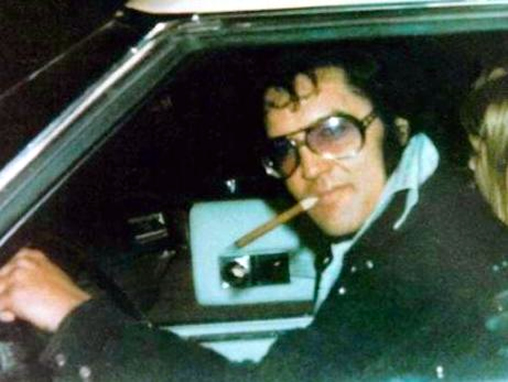Memphis icons meet | Elvis Presley's 1973 sessions at Stax Records
Source: Memphis Commercial Appeal
May 28, 2021

|
Elvis had a rich history of working in his hometown. He launched his recording career at Sun Records in the mid 1950s and then revived it at American Studios in 1969 in 1969. By the early 1970s, following his triumphant return to the stage, he was looking to start yet another chapter by cutting at Memphis' hottest house of music, Stax.
Over the decades, Elvis' July and December 1973 sessions at the South Memphis studio have remained a somewhat overlooked curiosity in Elvis' massive catalog. That's due, in part, to the fact it wasn't quite the full creative collaboration that music lovers would've liked. 'When you have these two huge icons from the same city, you want it to be more of a blend of those two forces', says Robert Gordon. 'But this was more of a facility rental for Elvis. Other than a couple backing tracks, there weren't a lot of Stax players involved. 'On one hand, it's not the historic thing you might expect from a Elvis Presley/Stax combination, but on the other hand it does represent a time when Elvis was making an effort to declare his independence in a way. And that was a hard process for him'.

By 1973, Elvis was at career and personal crossroads. His manager, Col. Tom Parker, had sold Elvis' back catalog to RCA for a huge lump sum, ensuring his financial freedom. After years with music publishers Hill & Range, Parker and Presley had also set up their own company, Whitehaven Music. 'It was a period of great opportunity', says Gordon, 'but it was also a bad time in his life'.
Elvis was in the midst of a divorce from his wife, Priscilla, and his mood had darkened. By the summer, RCA was on him to deliver more product, but Elvis didn't want to leave Memphis and his young daughter, Lisa Marie, to record.
Marty Lacker who had put Elvis together with Chips Moman and the American Studios band in 1969, was summoned to Graceland. 'When Elvis saw me, the first thing he said was, 'I need you to get me a studio here in Memphis', Marty Lacker recalls. Lacker immediately thought of Stax.
At the time, the Memphis soul label was exploding: Isaac Hayes' 'Shaft' soundtrack had been released the previous summer, and Stax had entered its second golden age. 'The company was cresting in a way', says Gordon.
Elvis had followed Stax's progress over the years. 'He loved the records coming out of Stax', Lacker says. 'He knew Isaac and the Staple Singers and Rufus Thomas and all those folks'.
Part of the reason Lacker suggested Stax was logistical: The studio had a proper security setup and guards at its gate, 'because Elvis sessions had to be closed', he says. Stax was also mere minutes from Graceland. 'It was that extra added enticement that he really didn't have to go far to work'.
By 1973, Stax had stopped renting the studio to outside acts. But the opportunity to host Elvis was too special to pass up. The label's resident superstar, Hayes, even gave up time he'd already booked to let Elvis record.
Given the proximity to his home, and Stax's white-hot status, it would've seemed like a match made in recording heaven, an opportunity for Elvis once again to be galvanized by working in his hometown. But the first set of sessions - held during the late-night hours of July 20-23 - was anything but magic.
July vs December
According to Ernst Jorgensen, the mood in the studio was completely different during the two sessions. Coming off six months of grinding stage work and dealing with divorce proceedings, Elvis was not a happy camper when the first Stax session began on July 20. According to Jorgensen, 'It was obvious from the start that something was very wrong with Elvis Presley'. Piano player Bobby Wood noticed that Elvis 'had gained weight. His eyes were yellow. His complexion was yellow … I couldn't believe it was the same guy. He looked totally different and acted totally different too'.
Elvis arrived at the studio three hours late the first night and later left without recording anything. He was late again the next night, and, according to Jorgensen, his speech was 'so slurred that he seemed scarcely awake. The sound of his voice on the session tapes makes it painfully evident that he had little interest in recording at all'. Lacking enthusiasm and with his mood rising and falling, Elvis finally finished 10 uninspired masters during the six nights in July.
Elvis returned to Stax in December with a much better attitude. 'With the divorce settlement behind him and no live engagements in the near future, RCA's demand for new material caught Elvis at a much better time than it had in July', Jorgensen judged. Still, over the course of six nights in the studio, Elvis's mood vacillated between excitement and frustration. He really got into some songs, like 'I Got a Feelin' in My Body' and 'Help Me', but there were many uninspiring filler songs recorded simply to meet RCA's quota. One night Elvis left 'in a huff' when he learned there was no food available in the studio.
Despite Elvis having started his own publishing company, the material chosen for the July session was still lacking. Sentimental and schmaltzy numbers like 'Three Corn Patches' did little to inspire Elvis' performances.
Even the more potent songs proved to be too loaded for Elvis to tackle at the time. Lacker recalls bringing Elvis a gorgeous ballad by Troy Seals and Donnie Fritts called 'We Had It All'. 'It's basically a guy singing to his ex-wife. And he loved it', says Lacker. 'He worked on it, rehearsed it four or fives times, and then he came over to me and said, 'I can't do this. I don't want the fans to think I'm singing this about Priscilla'.

In addition to a mix of members of Elvis' touring band (guitarist James Burton, drummer Ronnie Tutt) and a few former American Studios players (guitarist Reggie Young, bassist Tommy Cogbill), several Stax musicians, including MG's bassist Duck Dunn, drummer Al Jackson Jr. and guitarist Bobby Manuel, were summoned to play with Elvis.
'He was one of my heroes growing up', Manuel says. 'I was in awe of the guy, man'.
Manuel had gone into the session thinking Elvis would be dipping into the Stax catalog. 'Originally, we were told we were going to do some Stax-type material with him, Otis Redding's songs - which would've been incredible', Manuel says. 'I'm not sure what happened with that plan. There were different songs brought in. People were trying to get him to cut other things. He had a lot of pressure on him, I think. I wish we could have done some of those (Stax) songs, though. I think he would've enjoyed that. In the end, I guess we thought it was gonna be one thing, and it turned out it was another'.
If the July sessions had been a disappointment, it was an altogether different scenario when Elvis returned to the studio five months later for another week of recording.
The divorce with Priscilla had been made final that October, Elvis had found a new girlfriend in former Tennessee beauty queen Linda Thompson, and he had restored himself physically after a long stay in Baptist Hospital that fall for pleurisy and pneumonia. 'He'd survived the trauma of the divorce', Gordon says. 'He and Priscilla were able to maintain a relationship; it was all past him by then'.
A new mix of musicians greeted Elvis for the second set of sessions, including a few Muscle Shoals scene veterans like bassist Norbert Putnam. Putnam, who had worked with Elvis in 1970, realized immediately that the singer had come out the other side of a difficult time. 'He'd just gone through this horrible divorce. He'd gained a little weight and was not moving as quickly. But as soon we got into it, he quickly came alive'.
Putnam remembers Elvis taking command of the live recording session. 'He used his vocals to lead the band. When the King would get out there and get excited, it changed our dynamics. We really played to him'.
Elvis often would nail his vocal before the band had reached its peaks, and Putnam would have to lobby to do another take.

The convivial atmosphere that had always marked Elvis' best sessions was back. 'The King would come in and tell stories and clown around with us until we were totally relaxed', Putnam said. 'We'd forget he was the biggest rock-and-roll star in the world. Then he'd say, 'Let's record something'. We would start by 10 p.m., and by 3 or 4 a.m. we'd have half a dozen tracks done, including the vocals. We did something like 18 sides in a week's time, and it was great stuff'.
The material for the December sessions was much improved, with new songs from some of Elvis' favorite writers, including 'Burning Love' author Dennis Linde and 'Guitar Man' hitmaker Jerry Reed, being recorded alongside familiar covers of material by Chuck Berry and Waylon Jennings. Even an otherwise-slight piece, like 'Mr. Songman' - the story of a road-worn entertainer - was turned into a moving, deeply felt piece by a recharged Presley.
The results of the Stax sessions would be collected somewhat haphazardly with the bulk of the Stax cuts showed up on Raised On Rock/For Ol' Times Sake (1973), Good Times (1974), and Promised Land (1975). Though the Stax material would yield Elvis a trio of Top 20 hits, the recordings were lost in a deluge of product that included yet another live album and the ill-conceived spoken word effort, 'Having Fun with Elvis on Stage'.
Still, many of Elvis' Stax session performances stand out among his most vital. 'Because Elvis had set such a high bar, the (Stax) sessions haven't always been considered among his legendary material', says Gordon. 'But when you listen now, it's sort of a revelatory experience'.
The Stax sessions would not be the last recordings Elvis made in Memphis: He would cut his final tracks at Graceland's Jungle Room using a mobile recording unit in 1976.
But the Stax tracks would provide the last great glimpse of Elvis' powers before the slow fade of his final years.
Here are the 28 masters Elvis recorded at Stax in 1973:
- If You Don't Come Back
- Three Corn Patches
- Take Good Care of Her
- Find Out What's Happening
- I've Got A Thing About You Baby
- Just A Little Bit
- Raised On Rock
- For Ol' Times Sake
- Girl Of Mine
- Sweet Angeline
- I Got A Feelin' In My Body
- It's Midnight
- You Asked Me To
- If You Talk In Your Sleep
- Mr. Songman
- Thinking About You
- Love Song Of The Year
- Help Me
- My Boy
- Loving Arms
- Good Time Charlie's Got The Blues
- Talk About The Good Times
- Promised Land
- Your Love's Been A Long Time Coming
- There's A Honky Tonk Angel
- If That Isn't Love
- Spanish Eyes
- She Wears My Ring
Buy Good Times FTD Special Edition CD Release
Buy Promised Land FTD Special Edition CD Release
Buy Raised On Rock FTD Special Edition CD Release
![]() Norbert Putnam Reflects On The King
Norbert Putnam Reflects On The King
![]() Elvis Presley at merican Studios 1969
Elvis Presley at merican Studios 1969
![]() Ernst Jorgensen
Ernst Jorgensen
© Copyright 2024 by www.elvis.com.au & www.elvispresley.com.au
![]() https://biography.elvis.com.au/memphis-icons-meet-elvis-presleys-1973-sessions-at-stax-records.shtml
https://biography.elvis.com.au/memphis-icons-meet-elvis-presleys-1973-sessions-at-stax-records.shtml
No part of any article on this site may be re-printed for public display without permission.
 Tupelo's Own Elvis Presley DVD
Tupelo's Own Elvis Presley DVD
Never before have we seen an Elvis Presley concert from the 1950's with sound. Until Now! The DVD Contains recently discovered unreleased film of Elvis performing 6 songs, including Heartbreak Hotel and Don't Be Cruel, live in Tupelo Mississippi 1956. Included we see a live performance of the elusive Long Tall Sally seen here for the first time ever. + Plus Bonus DVD Audio.
This is an excellent release no fan should be without it.
The 'parade' footage is good to see as it puts you in the right context with color and b&w footage. The interviews of Elvis' Parents are well worth hearing too. The afternoon show footage is wonderful and electrifying : Here is Elvis in his prime rocking and rolling in front of 11.000 people. Highly recommended.
Tupelo's Own Elvis Presley DVD Video with Sound.





